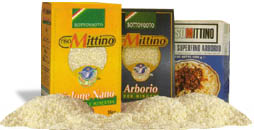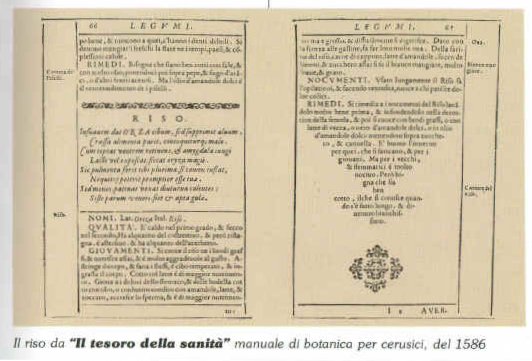THE STORY OF RICE |
|
 |
An ancient Indian legend documents the appearance of rice on the Earth, citing it as a wedding gift from the god Shiva to his beloved Retna. The spread of rice as a simple, substantial source of food was rapid both in the East, where it originated, and in the southerly regions of the West: Italy, France and Spain, which are still the leading rice producing countries in the West today. Depending on the latitude, the consumption of rice is both a ritual and a feast in which traditions and cultures merge.In Italy, for example, how can we forget the figure of the mondina (the name given to women who tended the rice by hand) who, in 1931, led to the creation of the Ente Risi (or Rice Association)? Rice is a cereal which requires a warm, humid climate, the climate prevailing in vast areas of China and Japan. In Italy it is cultivated by flooding the rice-fields. This technique of covering the plants with water protects the rice from the marked variations in temperature which might otherwise damage the young plants.The sowing, removal of weeds and harvest are the main stages in the cultivation of rice. They all take place between April and September. Its nutritional value means that it is one of the most complete, digestible foods available on account of a virtually total lack of cellulose.The only disadvantage to eating rice is in the case of people who suffer from diabetes or are overweight, on account of its high carbohydrate content. Current legislation protects every stage of rice-processing and precludes any kind of variation.Certain fundamental information must appear on every packet: the category of rice (it is forbidden to blend different types of rice and sell it in the same packet); the name of the rice and the use to which it should be put. Good-quality rice should have no smell, have a uniform colour and the grains of rice should be opaque and be free of marks. In the hand, raw rice should not leave any traces of white powder, which is a sign that the rice is old. |
|
|
|
Pearl of the Orient Eat up your rice, heaven will see to the rest. This is a Chinese proverb. 1600 years before Christ, the Emperor Kangh Hi realised that, in order to satisfy the food requirements of his populous country, he needed to discover a variety of rice that ripened quickly, which could be cultivated north of the Great Wall where, on account of the continental climate, the cold autumn weather arrived early. And so yu-mi or imperial rice was born. It became synonymous with early-ripening rice and is mentioned in many oriental legends. Today, the People's Republic of China produces 190,000,000,000 kg of rice. This may seem like an enormous amount, however, it is equivalent to one third of the world's annual production, which is approximately 500,000,000,000 kg a year. Rice farming around the world Around the world, the cultivation of rice has become much more extensive during the last 15 years. The amount of land devoted to rice cultivation has risen from 135 million hectares to approximately 148 million. Over the same period, harvests have increased by more than 44%. Furthermore, the yield from each hectare has improved: from 2,400 kg to 3,200 kg, an increase of approximately 32%. It has been calculated that, today, theoretically, each person on the Earth has access to 60 kg of rice, that is, 10 kg more than five years ago. This is already an effective contribution, but insufficient to cope with the fight against famine which has reached crisis proportions in Africa, Asia and South America. In these countries, rice is widely cultivated, since it has the same importance as bread in the West. A person in Japan consumes 80 kg of rice a year and a person in the Indo-Chinese peninsula consumes 150 kg, while, in Europe, we rarely consume more than 5 kg a head per year. How rice arrived in Italy More than 500 years ago, in Italy, the beginning s of rice cultivation were assisted by pressing needs: after plagues, endless wars and famine, a means had to be found of feeding the country's growing population regularly. For this purpose a cereal with a high yield was required to replace barley and rye, which had deteriorated in nutritional value, and rice proved to be what was needed. One of the first to recognise the potential of rice was Gian Galeazzo Sforza, Duke of Milan. In 1475, he sent some rice seed as a gift to the dukes of Ferrara, emphasising the capacity of this oriental cereal to multiply: each sack of rice seed would be transformed into 12 sacks of rice. However, several decades were to pass before rice-farming (Renaissance farming like that of sweetcorn and potatoes, which arrived in Europe after the discovery of America) was to establish itself firmly in the Po Valley. Not until the mid-16C would land devoted to rice cultivation increase from 5,000 to 50,000 hectares. And it was 1690 before the colonists from Europe began to cultivate rice in South Carolina. |
|
Leaders in Europe Italy is the leading European producer of rice. More than 215,000 hectares of land are devoted to rice cultivation, in descending order of importance, in the Provinces of Vercelli, Pavia, Novara, Milano, Alessandria, Ferrara, Oristano, Mantova, Verona and in a few limited areas of central and southern Italy. Annual production amounts to approximately 1,300,000,000 kg of raw rice, equivalent to 0.25% of world rice production. The yield from each hectare is, on average, 5,500-6,000 kg, whereas, a century ago, a hectare was unlikely to produce more than 2,400 kg. The national market absorbs 450,000,000 kg, other EU countries 350,000,000 kg and non-EU countries just under 400,000,000 kg. Therefore Italy is very active in terms of exporting rice and sells considerable quantities of its production on the international market, which, as far as rice is concerned, represents only 5% of the world harvest. In fact, 95% of global production is used for domestic consumption. Origins in Java Fossil remains have confirmed that, in Asia, people have eaten rice for at least 7,000 years. The rice plant is supposed to have originated in Java or Cambodia. The Egyptians were unaware of its existence and the Bible makes no mention of it. The Ancient Greeks and Romans, on the other hand, knew about rice, but regarded it as a spice. Pliny the Elder wrote in his "Natural History" that it had fleshy leaves. Theophrastus and Strabo were more explicit. The story of how rice travelled from the East to the West is fraught with mystery. It's possible that Alexander the Great introduced it to Greece. It is probable that the Arabs introduced it to Italy. Other versions of the story attribute the merit to the Venetians. According to an accounting book of the Dukes of Savoy, rice was already being sold in Turin in the 14C. During the Middle Ages, it was also cultivated in the botanical gardens of monastic orders. The monks of Montecassino studied it in depth and are supposed to have selected the first seeds for cultivation, giving rise to its success in the West as a food with extraordinary nutritional properties.
|
|
